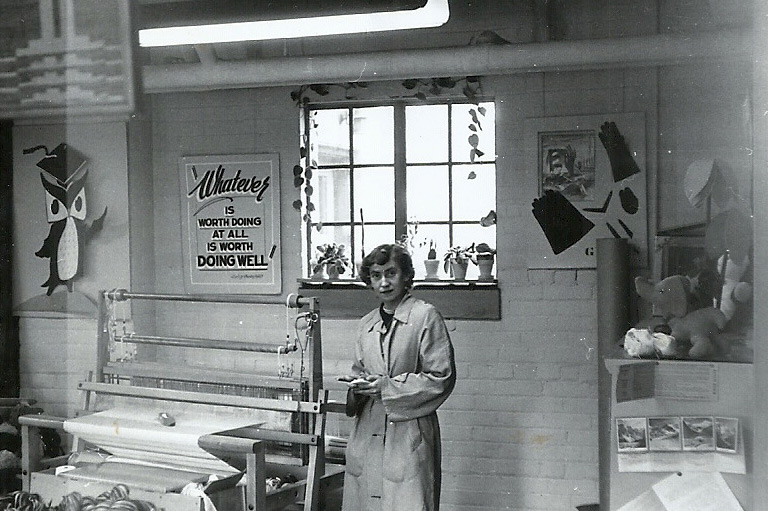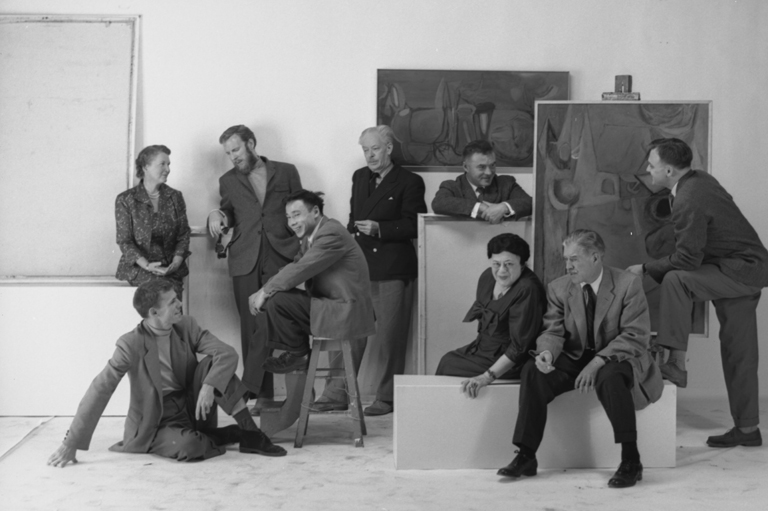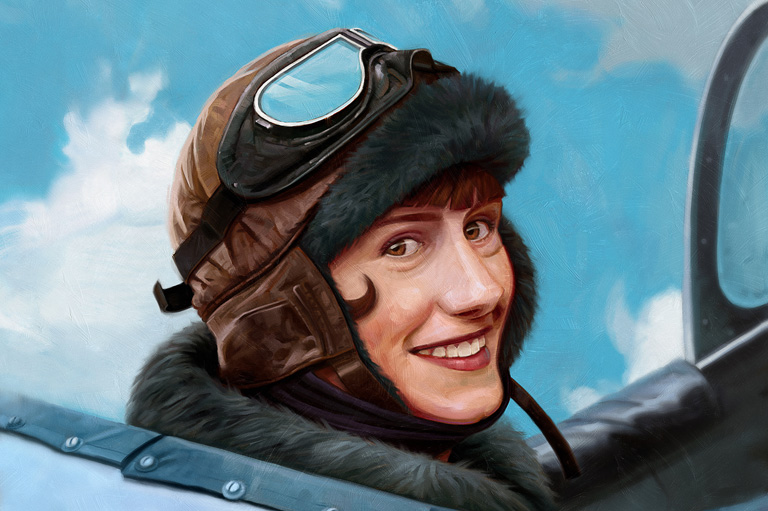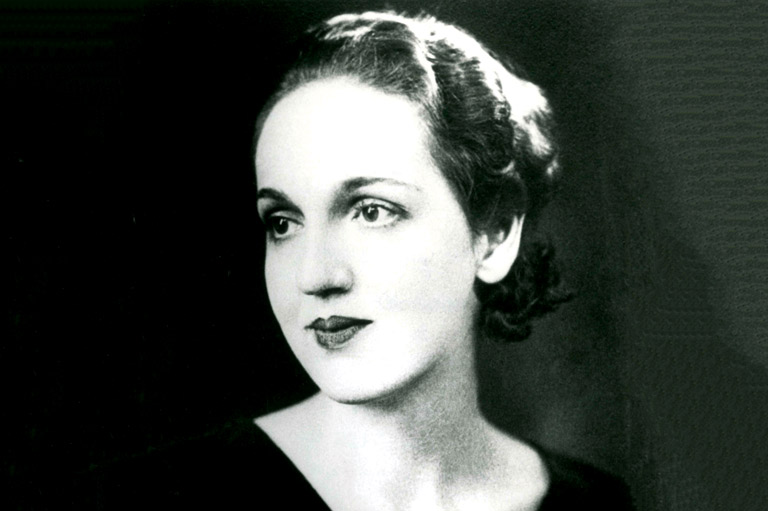The Watery World of Doris Slater's Art

In the early 1960s, Doris Slater Titus the family car, and drove south to spend the summer in Mexico with friends. The trip from Brantford, Ontario, to San Luis Potosi took several days, with many nights spent sleeping in cheap motels along the way. At the crossing into Mexico, her daughter Patti Thomas remembered, the border agent expressed astonishment at this petite woman — with two children aged ten and thirteen — travelling such a long distance on her own. “You loco?” he asked her. At the end of summer, when it was time to return to Brantford, money was running so low that the family slept overnight in the car in gas station parking lots. For Thomas, it was a reflection of her mother’s adventurous spirit and “our best holiday ever.”
Doris Slater Titus was born Doris Slater in an agricultural community outside Chatham, Ontario, in 1917. When she was a child, her father was offered a government position with the roads department, and the family moved to Toronto. After graduating from Oakwood Collegiate Institute, Slater enrolled in the Ontario College of Art (now OCAD University) in 1935, specializing in commercial illustration. She received multiple scholarships during her studies, most notably from Adelaide McLaughlin, whose husband, Sam McLaughlin, founded the General Motors of Canada plant in Oshawa in 1918.
Upon graduating from the Ontario College of Art in 1939, Slater was frequently evaluated for her physical appearance, rather than for the merits of her professional work. Later that year, she co-judged the Miss Toronto beauty contest at the Canadian National Exhibition, sponsored by the Toronto Police Amateur Athletic Association. A headline from the Toronto Daily Star — accompanied by her full-length photograph — read: “There’ll be Beauty on the Bench, too, at Police Contest.” Interviewed for the piece, Slater told the reporter that “the idea of an ‘oomph’ girl doesn’t rate with her” — instead, she was looking to give the award to someone with an “exciting look in her eyes.”
Though it’s believed that she was occasionally employed on commercial illustration projects at this time, it wasn’t until her sister Minnie’s marriage to Celtic Donaldson during the early years of the Second World War that Slater finally caught her big break. Donaldson’s brother-in-law Ted McCall was the editor of the Toronto Evening Telegram and a contributor to the Canadian comic-book publisher Anglo- American Publications. It was likely McCall who persuaded Anglo-American to hire Slater as an illustrator.
With 7 uniquely curated newsletters to choose from, we have something for everyone.
Under the pseudonym Macduff, McCall wrote and Slater drew the comic strip “Pat the Air Cadet.” First appearing in a 1941 issue of Grand Slam Comics, “Pat the Air Cadet” chronicled the spirited exploits of sister-brother team Pat and Jerry, who foiled Axis conspiracies. The accomplishment made Slater the first woman in Canadian history to work as a comic-book artist, although she was not credited for it, since her name didn’t appear on the strip. Extraordinarily, Slater never spoke of working in the wartime comic industry, both her daughter and her niece Nancy Lee recalled. But, thanks to the work of historian Ivan Kocmarek and the Joe Shuster Canadian Comic Book Creator Awards, McCall’s and Slater’s successes have recently come to light.
Slater’s most successful comic-strip project was also her final one, “Penny’s Diary.” Around 1944, Slater secured the rights to reproduce Pat Joudry’s CFRB radio program of the same name for comic-book publisher Bell Features. “Penny’s Diary” depicted the highs and heartbreaks of its heroine, Penny, as she navigated the quirks of everyday teenage life. An immediate hit for Active Comics, “Penny’s Diary” soon appeared on the cover of the publication, becoming the only Canadian war-era comic book illustrated by a woman to do so.
Possibly to gather source material for her comics, Slater was known to visit train stations to sketch people on the platform as they embarked and disembarked. One of these was Canadian crooner Russ Titus, then a member of the Entertainment Corps returning from serenading soldiers in Verdun, Quebec. Struck by her drawings, he chatted with her on the platform, and they soon began dating. Several months later, the couple wed at the Slater family cottage in Arden, Ontario. Their first child, Robin, was born in 1946, followed by Patti in 1949.
“In my mother’s scrapbook,” Thomas said, “there were cartoon drawings she did of my father and herself during the war with speech balloons over them. She’d fill in her balloon with something and leave his balloon blank, then she’d send these cartoons to where my father was stationed, and he’d fill in his balloon and send them back to my mother.” Lamentably, their relationship ended, and Titus relocated to England. There he changed his name to Larry Cross and appeared in television shows including the 1960s spy series The Avengers and in films like the 1967 comedy A Countess from Hong Kong.
Slater — now Slater Titus — found herself a single mother raising two young children. Though she maintained her focus on her career as a working artist, Thomas observed, “we never for one moment were made to feel she valued her role as mother to us any less than 150 per cent, as she was mother and father to us.”
Slater Titus made ends meet by taking on design and illustration projects. For instance, she was hired to paint a series of murals based on nursery rhymes like “Humpty Dumpty” and “Jack and Jill” in Toronto’s Hospital for Sick Children. Sadly, the murals no longer exist.
She also contributed a number of drawings for Byng Whitteker’s Baby Bee’s book series. Her archives include a handful of loving, affectionate drawings of her children, who appeared to serve as the muses for Baby Bee’s content. “Her sketches and paintings of my brother were always spot-on,” said Thomas. “No wonder he carried so many of her artworks with him from age seventeen ’til he died in his seventies, almost as if he knew he must be the custodian to preserve her work for the future. Our bonds with our mother were beyond words.”
Advertisement
In 1952, Slater Titus accepted the position of art teacher at Brantford Collegiate Institute and resettled her family in Brantford. She quickly became a fixture in the art community, joining the Brantford Art League and co- founding the Brantford Sketch Club, which convened on the grounds of Glenhyrst, a sixteen-acre estate and manor house dedicated to arts and culture. She updated her artistic skills by attending art classes at the Doon School of Fine Arts in the village of Doon, Ontario, now part of the city of Kitchener. There she was instructed by prominent Brantford artist Toni Onley. The two artists struck a lasting friendship, and, under Onley’s tutelage, Slater Titus started to experiment with abstract painting. She was later interviewed about abstract art by the local newspaper, the Brantford Expositor: “Mrs. Titus described abstract art as a subject people needed to study to understand — not just dismiss it with a laugh because it did not make sense at first glance.... In the ‘modern’ styles, the artists painted not what they saw but what they felt about what they saw.” The article ends by saying: “Art as a whole was blossoming in Canada, Mrs. Titus said. Everyone was a potential artist.”
Freed from the rigidity of commercial illustration and the representational imagery of comic strips, she took to cub- ism and pointillism with verve. Yet Slater Titus remained restless and unsatisfied, so she packed up her materials and brought them to the banks of the Grand River. After carefully arranging pigments on Masonite boards, she submerged them in the flowing water and hung them in trees to dry. In this poetic gesture, extraordinary for its time, she painted with the river’s current. But she didn’t stop there. According to Thomas, while her mother was at the family cottage in Arden, she was known to mix the water and beach sand of Big Cedar Lake with her paint.
The burgeoning women’s rights movement inflamed her hunger for innovation. Whispers of Slater Titus painting with her own bathwater circulated among family members after her death. In counterpoint to the social conservatism of the late 1950s and the domestic archetype of TV house-wife June Cleaver, Slater would gather used bathwater from her tub, combine it with pigment, and use it to create abstract paintings. These paintings represent her body with a personal agency that the reporters writing about the police beauty contest could not have imagined. “My brother knew about the bathwater and told me during phone calls,” Thomas said. “I assume she probably told her arty friends, too.” Though it’s unknown which works were painted with her bathwater, that’s likely the point — and she probably would have had a laugh about strangers admiring her work without being aware of its unconventional methods.
In 1960, Slater Titus took a job as an art teacher at Ottawa’s High School of Commerce, largely motivated by better pay. In June 1964, committed to leading a summer studio course at the Ontario College of Art, she left Ottawa bound for Toronto, along with fifteen-year-old Patti and Onley’s thirteen-year-old daughter, Jennifer, whom she was caring for at the time. On Highway 7 outside of Stittsville, Ontario, an oncoming driver crossed the median and struck their vehicle. Slater Titus and Jennifer Onley were both killed in the collision, while Patti emerged from the back seat with minor injuries and no memory of the accident. Slater Titus was forty-seven when she died.
Save as much as 40% off the cover price! 4 issues per year as low as $29.95. Available in print and digital. Tariff-exempt!
The story of Doris Slater Titus is one of many firsts, daring innovations, and impatience with the status quo. Seventy years after she moved to Brantford, her presence in the city endures through public and private collections. Downtown at the Sergeant William Merrifield VC Armoury, her large-scale mural depicting the historical achievements of the 56th Field Artillery Regiment hangs in the officers’ mess. The mural has left the armoury only once, when it was publicly exhibited at Glenhyrst during a retrospective exhibition of the artist’s work in 2021.
The Glenhyrst Art Gallery has a variety of significant works by Slater Titus in its permanent collection: abstract landscape paintings, figurative works, and a 1956 pastel drawing of Patti holding a cat, titled Portrait of a Girl. A public art initiative called the Grand Exhibit reproduced one of her works on weatherproof aluminium: The untitled, cubism-inspired green landscape is installed at Brantford’s Market Centre Parkade so that anyone can experience it at any time of day. Slater Titus also produced paintings and drawings for family, friends, and colleagues in Brantford that have been passed to descendants through generations. Many of them grace the walls of their homes to this day.
If you believe that stories of women’s history should be more widely known, help us do more.
Your donation of $10, $25, or whatever amount you like, will allow Canada’s History to share women’s stories with readers of all ages, ensuring the widest possible audience can access these stories for free.
Any amount helps, or better yet, start a monthly donation today. Your support makes all the difference. Thank you!
Themes associated with this article
Advertisement









